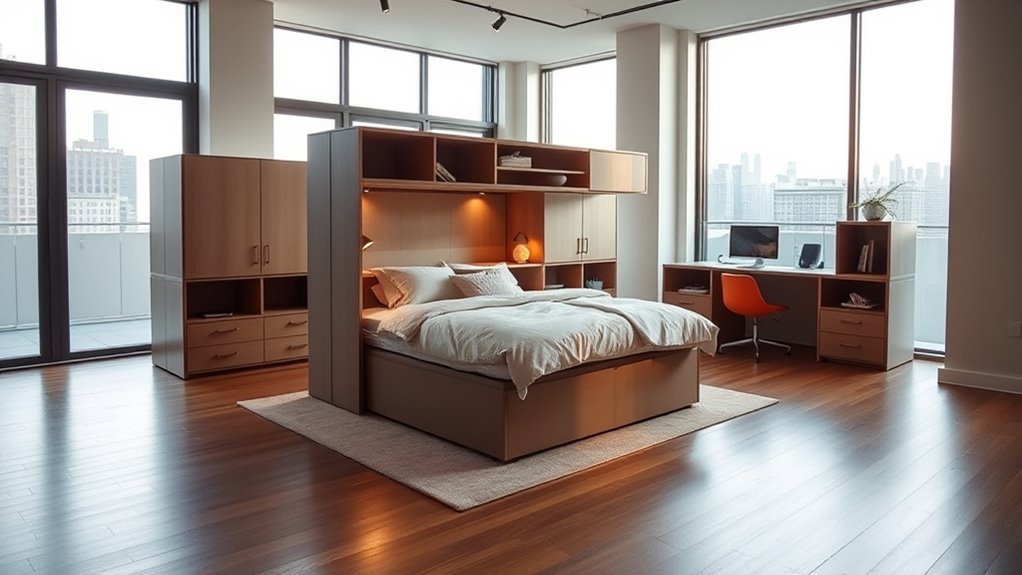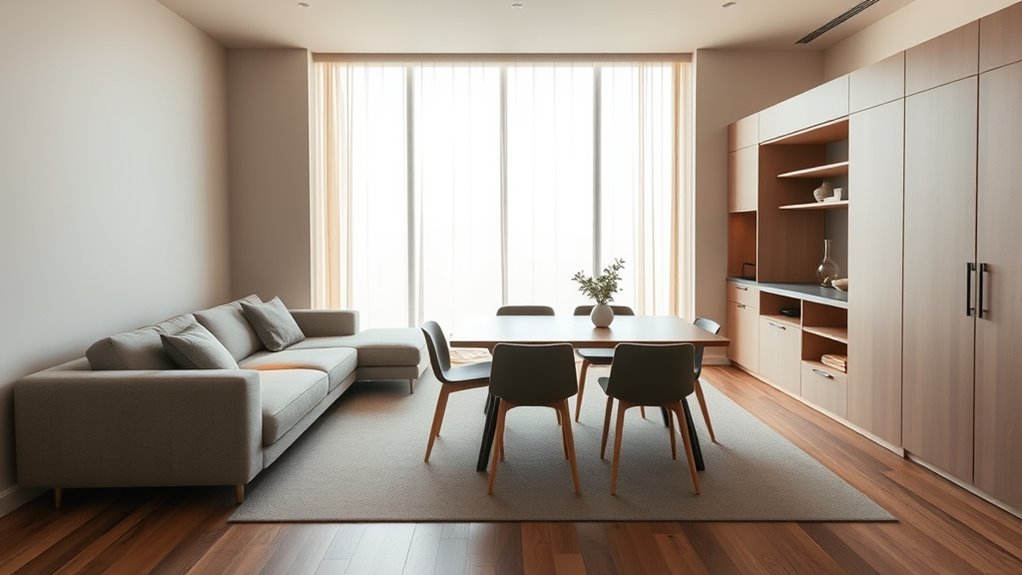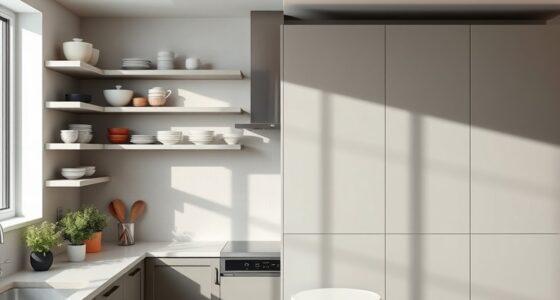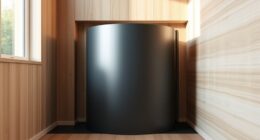Flexible and adaptable living spaces let you easily switch up your environment to fit your changing needs and routines. You can incorporate multifunctional furniture like sofa beds and convertible tables to save space and boost convenience. Modular designs with movable walls and storage options help you create dedicated areas for work, relaxation, or socializing. By choosing lightweight and easily reconfigurable pieces, you can make your home more practical and inspiring. Keep exploring to discover even more ways to transform your space effortlessly.
Key Takeaways
- Incorporate multifunctional furniture like sofa beds and convertible tables to maximize space and versatility.
- Use modular room elements such as movable walls and customizable furniture to reconfigure layouts easily.
- Optimize storage with modular shelving and stackable units that adapt to changing needs.
- Select lightweight, on-wheels furniture for quick adjustments and layout experimentation.
- Design open, flexible spaces that promote minimalist organization and support evolving routines.

Flexible living spaces are transforming the way you design and use your home, allowing for adaptability to your changing needs. Imagine a space that shifts seamlessly from a cozy living room to a productive home office or a guest bedroom—this is the power of multifunctional furniture and modular room designs. These solutions enable you to make the most of limited space, maximizing functionality without sacrificing style. When you incorporate multifunctional furniture, you eliminate clutter and create versatile areas that serve multiple purposes. Think of a sofa bed that transforms into a guest bed, or a dining table that doubles as a workspace. These pieces not only save space but also make everyday living more convenient and efficient. Modular room designs take this concept further by allowing you to customize your environment. Walls, partitions, and furniture modules can be rearranged easily, giving you the freedom to tailor your space as your lifestyle evolves. If you need a quiet zone for work during the day, you can set up a partition to create a dedicated workspace; when friends visit, you can reconfigure the layout for social gatherings. This flexibility encourages a dynamic home environment where your space adapts to your routines and priorities.
You can also leverage modular designs to optimize storage solutions. Instead of traditional built-in closets, consider modular shelving units or stackable storage cubes that can be moved or expanded as needed. This way, you keep your home organized without sacrificing open space or aesthetic appeal. The key is choosing furniture and design elements that are not only functional but also easy to manipulate. Lightweight, collapsible, or on-wheels designs make reconfiguration simple and quick, so you’re encouraged to experiment with different layouts. As your needs change—maybe you start working from home more often or welcome new family members—your space can evolve without costly renovations or extensive remodeling.
Understanding asset division laws can help you plan your home modifications strategically, especially if you’re considering investments in adaptable furniture or modular designs as part of your property value. Flexibility in your living space also promotes a minimalist mindset, helping you focus on what truly matters. When your environment adapts to your life rather than the other way around, you create a home that’s both practical and inspiring. By investing in multifunctional furniture and modular room designs, you gain the freedom to reimagine your space continually. This approach not only improves functionality but also makes your home more responsive to your lifestyle, ensuring it remains a comfortable, efficient sanctuary no matter how your needs shift over time.
Frequently Asked Questions
How Cost-Effective Are Flexible Living Space Solutions?
Flexible living space solutions are quite cost-effective because they save you money on renovations and furniture. By adapting your space, you can maximize its use, reducing the need for extra rooms or expensive upgrades. This helps with budget planning, ensuring you allocate funds efficiently. Over time, these solutions lower overall costs, making them a smart choice for those looking to cut expenses while maintaining a functional, versatile living environment.
What Are the Best Materials for Adaptable Furniture?
You should choose durable materials like high-quality plywood, metal, or ABS plastic for adaptable furniture. Multi-purpose furniture and modular designs benefit from these materials because they withstand frequent reconfiguration and daily use. Plywood offers strength and versatility, metal provides stability, and ABS plastic is lightweight and easy to clean. By selecting these materials, you guarantee your furniture remains functional and long-lasting as your needs change.
Can Flexible Spaces Increase Property Value?
Yes, flexible spaces can boost your property value. By incorporating smart home integration and staying current with interior design trends, you create a more appealing and functional environment. Buyers appreciate adaptable layouts that suit their needs, making your property stand out. Plus, modern features like smart tech and versatile furniture demonstrate updated living solutions, which can lead to a higher resale price and faster sales.
How Secure Are Movable Walls and Partitions?
Movable walls and partitions are generally secure when installed properly, but around 30% of homeowners worry about security concerns. Their structural integrity depends on quality materials and professional installation. You should verify they meet safety standards and are regularly checked for stability. While they offer flexibility, don’t overlook potential risks; proper maintenance and choosing reputable products help keep your space safe and secure.
What Maintenance Is Required for Adaptable Features?
You need to regularly perform cleaning routines on your adaptable features to keep them in good condition. Check for wear and tear, especially on moving parts like hinges or tracks, and address any issues promptly. Lubricate mechanisms when needed, tighten loose fittings, and inspect for damage. Consistent maintenance guarantees your adaptable spaces stay functional and look great, preventing costly repairs down the line. Keep up with these routines to maximize longevity.
Conclusion
As you embrace flexible living spaces, imagine the endless possibilities ahead. Every wall, piece of furniture, or design choice could transform your home into something entirely new—but what’s the next innovation that will redefine comfort and functionality? Stay curious, because the future of adaptable living is just beginning, and you’re right on the edge of discovering something truly extraordinary. Are you ready to open the potential waiting inside your space? The next chapter is closer than you think.









